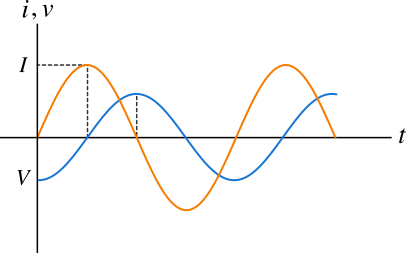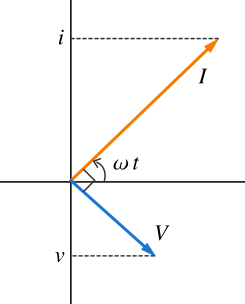The capacitors play differently in circuits from inductors. Similar to inductive reactance, the capacitor also has the reactance similar to resistance of a resistor. Here we take a look at capacitive reactance and how it can change.
Effect of capacitor in AC circuit
What is the effect of capacitor in AC circuit? The answer is capacitive reactance. What we have here is a capacitor with the alternating source of emf. The alternating source of emf produces alternating current. The Figure 1 shows a capacitor with an ac source.

Let the alternating current be
\[i = I \sin(\omega\,t) \tag{1} \label{1}\]
You know that, the current at any instant \(i\) is the rate of change of charge on the capacitor, that is \(i = dq/dt\). So,
\[dq/dt = I \sin(\omega\,t)\]
Integrating the above equation, you'll get
\[q = -\frac{I}{\omega}\cos(\omega\,t)\]
We know that, \(C = q/v\), where \(v\) is the voltage across the capacitor at any instant, and \(v = q/C\), therefore
\[v = -\frac{I}{C\omega}\cos(\omega\,t) = \frac{I}{C\omega}\sin(\omega\,t - \pi/2) \tag{2}\label{2}\]
From Equations \eqref{1} and \eqref{2}, you can see that the voltage lags behind the current by \(90^{\circ}\). The Figure 2 shows the functions of both voltage and current as a function of time.

The phasor diagram showing the phasors of voltage and current is shown in Figure 3. The projection of the phasor gives the instantaneous value of the quantity represented by the phasor.

From Equation \eqref{2}, the voltage amplitude is \(V = I/C\omega\), and the term \(1/C\omega\) acts as the resistance called capacitive reactance denoted by \(X_C\). Therefore,
\[X_C = \frac{1}{C\omega} \tag{3} \label{3}\]
So, \(V = IX_C\), and it has the similar form of \(V = IR\) for direct current. The SI unit of capacitive reactance is the same as that of resistance which is \(\Omega\) (Ohm). As you can see that the capacitive reactance is inversely proportional to the angular frequency. The greater the angular frequency, the less the capacitive reactance, and therefore they allow the higher frequency and block lower frequency or dc. The filter that allows the high frequency is called high-pass filter.





